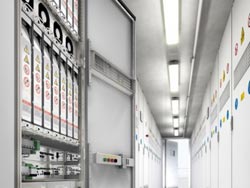Power Storage Buffers Fluctuating Solar Power

The aim is to provide a buffer against short-term fluctuations in output from renewable energy sources. Such fluctuations can last for seconds or several minutes long. The modular designed Siestorage battery is based on lithium-ion rechargeable battery technology and fits into a normal shipping container.
In its big layout it stores 500 kilowatt-hours of electricity. That's about the average daily power consumption of 50 households. The Italian power company Enel recently switched on the first Siestorage installation, which has a capacity of one megawatt. Enel is using the installation, which is connected to its primary distribution network, to study how voltage can be stabilized.
The electrical output of photovoltaic arrays doesn't only fluctuate with the seasons or between night and day. It's also affected by local weather. For example, power production sags for a few seconds (or even minutes) if clouds drift over the modules. Consequently, the grid experiences brief drops in voltage. Energy storage devices deal with these fluctuations within milliseconds in the power grid itself. As a result, there's no need to adjust controls at power stations – a procedure that reduces efficiency and increases costs.
During development, Siemens worked together with one of the world's largest manufacturers of lithium-ion batteries. Thanks to the system's modular design, its capacity can be expanded to two megawatt hours at an output of 8 megawatts. The complete solution with the inverter module and the controller that connect the system to the grid are from Siemens.
Enel will also study how well the system can handle a controlled restart of a grid after a complete blackout. To achieve this feat, the system's inverter has to regulate the right voltage and frequency so that the grid can be powered up in a controlled manner. Such a solution would be very interesting for small independent power grids on islands or in remote areas, which would otherwise have to be connected to neighboring grids.
Energy storage systems form part of Siemens solutions for tomorrow's smart grid. They are part of Siemens' environmental portfolio, with which the company generated about €30 billion in sales in 2011.
Media Contact
More Information:
http://www.siemens.com/innovationnewsAll latest news from the category: Power and Electrical Engineering
This topic covers issues related to energy generation, conversion, transportation and consumption and how the industry is addressing the challenge of energy efficiency in general.
innovations-report provides in-depth and informative reports and articles on subjects ranging from wind energy, fuel cell technology, solar energy, geothermal energy, petroleum, gas, nuclear engineering, alternative energy and energy efficiency to fusion, hydrogen and superconductor technologies.
Newest articles

How 3D printers can give robots a soft touch
Soft skin coverings and touch sensors have emerged as a promising feature for robots that are both safer and more intuitive for human interaction, but they are expensive and difficult…

Oxygen vacancies mediated ultrathin Bi4O5Br2 nanosheets
… as efficient piezocatalyst for synthesis of H2O2 from pure water. As an important chemical raw material, hydrogen peroxide (H2O2) is widely applied in various aspects of industry and life….

Atom-by-atom: Imaging structural transformations in 2D materials
Silicon-based electronics are approaching their physical limitations and new materials are needed to keep up with current technological demands. Two-dimensional (2D) materials have a rich array of properties, including superconductivity…





















